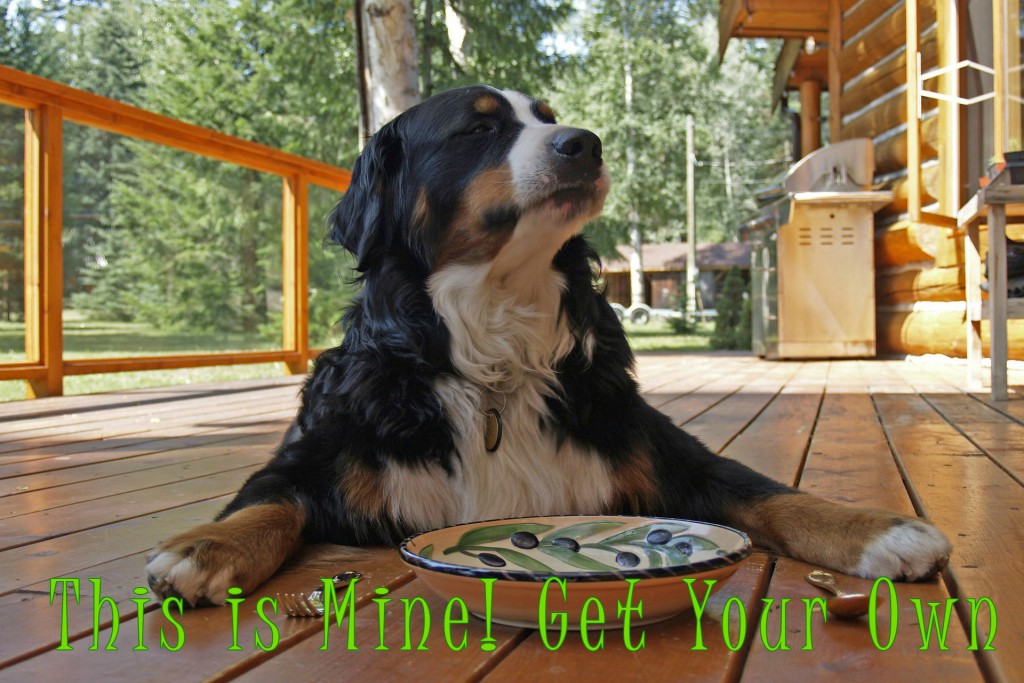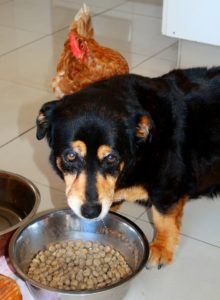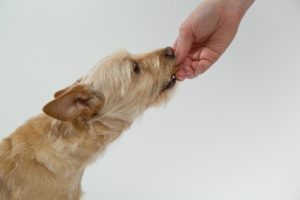
Resource guarding in dogs is a pretty common issue many pet parents experience, and can occur in dogs of all ages, seniors included.
Although dogs can guard many resources, in this post we will be talking specifically about how to help a dog who guards food.
What is a resource?
A resource is anything a dog considers to be a treasure, something of high value. It could be toys, food, treats, his bed, people or even territory.
What is resource guarding?
It refers to a dog guarding an object or objects he deems valuable, by using body language or aggressive behaviour.
What is guarding behaviour?
It is the behaviour exhibited to protect that/those resource(s). It could be running away with the object, a curled lip before the growl begins, chasing the person away, growling, snapping, barking or biting.
A bit more info…
Resource guarding doesn’t look just one way. What I mean by that is some dogs…
- Only guard something they are actually sitting with or holding, like a toy or bone
 Guard their food
Guard their food- Guard their bones or toys they’re not even interested in at that moment
- Don’t let anyone near their bed
- Guard their resources from people, other dogs or both.
Guarding behaviour can vary in terms of severity from a dog picking up the object and moving it away, to chasing you away, snarling, growling even biting.
Is it common? Why do dogs do it?
It is relatively common, but there isn’t one reason why dogs do it. Here are some of the reasons it is believed to happen.
If dogs are competing for limited food, the one that has access first has the best chance of survival, so naturally he will do his best to protect it from others.
It could be a genetic trait.
A learned experience.
Perhaps a sibling or other dog they lived with used to take things away, so now your dog has started guarding certain objects.
You know when a dog picks up something they found that they shouldn’t have, then you grab it away from him? Does he run away with the object the next time he finds it? Do you chase after  him, yelling at him to give it back? Picture the scenario – you’re standing over him yelling, he’s growling at you and not paying any attention.
him, yelling at him to give it back? Picture the scenario – you’re standing over him yelling, he’s growling at you and not paying any attention.
You know what he’s learning? He doesn’t have to listen to you, and if he shows aggression, you back off.
Congratulations!! Your dog has now learned how to resource guard.
What does guarding behaviour say about the dog?
A dog that guards is often insecure, seeing anyone as a threat to the possible loss of a resource that makes him feel good.
An all too common scenario
Many people who live with resource guarders don’t understand the behaviour. They get angry and confrontational, causing their dog to guard even more and the cycle continues.
He has been warning you, but you’ve been ignoring him. The next time he may not bother with the warnings, and go straight to the aggressive behaviour, like biting.
 When that happens people surrender their dogs, the shelter finds out he bit someone, and that story won’t have a happy ending.
When that happens people surrender their dogs, the shelter finds out he bit someone, and that story won’t have a happy ending.
What you should never do
- Never, ever, ever punish your dog. The fact that you aren’t understanding the behaviour, or how to help him, is not your dog’s fault.
- Don’t try and wrestle the item away from him.
Consequences of living with a resource guarding dog
The impact that may have on family members, especially if there are children in the home can be quite serious. Your kids don’t know how to interpret your dog’s signs and can get hurt.
What you can do to help
Below you will find two different step by step methods, to help stop your dog guarding his food. The goal is to show your dog good things happen when you approach, and reach, for his food bowl.
A quick mention before we start
Before we start I should mention that we’re going on the assumption you are feeding your dog two set meals a day, rather than free feeding (leaving food out for him all day). If you aren’t, now is the time to start. It is a much better way for your dog to eat anyway, rather than allowing him to graze all day long. If you have to get him used to eating set meals, start with that first then do the training.
Feed him once in the morning, and once in the late afternoon. Show him the food, leave it down for 15-20 minutes, then pick it up. If he didn’t eat, try again during the next scheduled time. It may take a couple of days, but your dog won’t let himself starve. If you’re having serious problems with him eating, consult your vet to make sure he’s feeling okay.
How to stop a dog guarding his food bowl
Vary feeding times
I have always fed all my dogs on a schedule, and it never fails – their body clocks start them off about 30 minutes before meal time and they’re on high alert! For a dog who guards his food that is a problem, because his anxiety is already starting to build in anticipation of what always happens. For that reason, vary the feeding times a bit so he never quite knows when it’s coming.
Change the location
Feed him from a new bowl in a different location, breaking the pattern and cycle of his anxiety.
The technique
You want nothing but positive associations at meal time – for your dog to know he gets delicious treats when you approach his bowl, and he never has to worry that anything is being taken away.
Here’s what you do
Step 1
Pick up your dog’s empty bowl, make it look like you’re filling it with food, then put it on the floor. When he looks at you with that “what’s with the empty bowl look” praise him and give him a bit of food. Once he’s finished and looks at you again, add a little more. Repeat this until his portion for that meal has been eaten. Walk away, then come right back and add just a bit more.
You want your dog to see that good things happen when you approach.
Feed him each meal this way for about a week, longer if necessary depending on the severity of his guarding behaviour. As he becomes more and more comfortable with you being so close to his bowl, you’ll add more food each time until you can put down a full bowl of food, and he will eat it with you standing next to him.
Step 2
Walk by his empty bowl and throw a high value treat in. A high value treat is something your dog loves, but doesn’t usually get. It could be chicken, ham, liver, hot dogs, cheese… Do that several times over the course of a week or so. Again you want to show your dog that good things happen when you approach.
Step 3
Throw that high value treat in his bowl while he’s in the middle of eating a meal. He should be relaxed enough to eat with you near him.
If at any point he seems stressed, or shows that guarding behaviour again, you may have moved too quickly. Back up to the point where he was still relaxed, and progress a little slower.
Here is another method to try. The goal is the same, but with more steps and a slight variation
Let me re-iterate – the goal of any of these exercises is to show your dog that good things happen when you’re near his food bowl.
Step 1
While your dog is eating keep your distance so he’s not in guarding mode. In a fun tone say something like “what’s that?” or “what are you eating?” or whatever sentence you choose, then throw a high value treat into his bowl. Hopefully the distance you need to be for him to be comfortable, and your throwing arm, are compatible!!
Don’t worry if it misses the bowl sometimes, let him find it don’t you go get it. Do this a few times throughout the meal. Keep the pieces small but not too small that he can’t enjoy what you’re giving him.
Keep this up each time your dog eats, and do not move on to step 2 until your dog has been relaxed eating in this manner for one week (14 meals). If at any point he’s exhibiting, or about to exhibit, guarding behaviour, you may be standing too close so take a step or two back, and just carry on.
It’s entirely possible that at some points during this exercise, your dog will leave his food and come to you looking for treats. It’s a good sign but ignore him. He only gets the treat when he’s at his bowl eating.
Step 2
Your dog has been relaxed with you tossing treats into his bowl, and you’re both ready for the next step. You’re doing pretty much the same thing as you’ve been doing – asking him what he has there and tossing him a treat, only this time you are taking one step forward, tossing him the treat, then taking one step back.
You see the difference?
In step 1 you were remaining in place when giving him treats, now you are taking one step forward, throwing it then going back. Repeat this several times throughout his meal.
Every day take one very small step closer. If at any point your dog is starting to show guarding behaviour, you may have progressed too quickly. Go back to the distance he was comfortable, and rather than taking a step closer every day, try every other day.
Step 3
By this point you should be able to ask him again what he has there, walk up to the bowl, drop a treat in then walk away. Don’t stare at your dog, be cool just walk over and do it. Do this for a week of meals, then you can move on.
Step 4
By this point your dog should be ready to take a treat from your hand, so let’s see how we accomplish that!
While your dog is eating, and saying that same sentence you decided on in step 1, take a treat in your hand, walk right next to your dog, bend over ever so slightly and encourage him to eat the  treat from your hand. Once he does, turn around and walk away. You know the drill, repeat until he finishes his meal.
treat from your hand. Once he does, turn around and walk away. You know the drill, repeat until he finishes his meal.
Repeat this each day, bending just a little bit each time. As you’re bending your hand is moving ever so slightly closer to the bowl. Keep doing this exercise, slowly, until you are at the point where he is relaxed enough to allow you to give him a treat next to his food bowl for about a week. Once this happens, move on to the next step.
Step 5
Now that you’re able to bend down near your dog’s bowl and give him a treat, the goal of this step is for you to touch his bowl with one hand, while giving him the treat with the other. As before, once the treat is given, turn around and walk away and repeat several times. As always, remain at this step until you can touch his bowl during about a week of meals, while he is relaxed.
Step 6
Approaching him with your usual greeting stand next to your dog, bend over to pick up the bowl and raise it just a few inches off the ground, drop a treat in it, put the bowl back down and walk away. Repeat.
Step 7
The same as step 6 but you’re raising the bowl higher off the ground to put the treat in, then putting it back down for your dog to eat. Ultimately you want to be able to stand straight while holding his bowl.
Step 8
You are now able to reach down, pick your dog’s food bowl up and he’s okay with it. Now you’re going to walk over to the counter, put the treat in the bowl over there, then return the bowl to your dog and repeat.
Step 9
Everyone in the household has to go through steps 1-8, but do it one person at a time.
I think I hear you groaning! Understandable, it’s a very lengthy process, and does require your time and effort at each feeding. It has so many steps for a reason. The best way to help is to make it as gradual a process as possible, changing your dog’s attitude from seeing you as a threat to his prized possession(s), to the giver of something wonderful whenever you’re near him at meal times.
It’s not your dog’s fault he guards his resource, and as our dogs’ guardians, it is our responsibility to do whatever we can to help and this is one of those times, and one of those ways!!
A quick mention
Obviously I have no idea how aggressively your dog guards his food, but it’s best to take such baby steps so we help your dog very slowly adjust. If your dog is not that aggressive, or is really responding well, you could do each step for 6 days, or even 5 rather than 7.
Please take it slowly, rushing training doesn’t benefit anyone.
Resource guarding – conclusion
I know there’s a lot of information here, but it’s all broken up into very easy to follow baby steps. It may seem overwhelming at first, but take some time to read each step to get a better understanding of what’s involved, then choose whichever plan you want to try first. If your dog is very aggressive, the second plan with 8 steps may be better, but it’s entirely up to you.
If you aren’t feeling very sure about tackling this on your own, or you aren’t seeing the results, find a qualified trainer or someone experienced in dog behaviour.
I have an online pet consultancy service, so if you prefer to contact me for help through video call, I am certainly happy to do that.
Resource guarding comes in degrees of severity, so start helping your dog now before it gets any worse.


 Retractable Dog Leashes: Why Are We So Obsessed With Using Them?
Retractable Dog Leashes: Why Are We So Obsessed With Using Them?
Hi Hindy,
These are great tips on working with a dog that resource guards. Our youngest, Lexi, came into our lives about 18 months ago. She was roughly 12 weeks old. She came from an informal settlement where dogs run stray, fight to survive and scavenge for food.
She used to resource guard me and certain toys from our 3 year old male. Strangely, not food. I spent months working on counter conditioning in a million different scenarios. At one stage it got really bad and then suddenly the work paid off!
Hi Rosemary,
Poor Lexi, so heartbreaking to hear the rough starts some animals have in life. Lucky for her she found you! That’s the thing with training as you know – it’s constant, consistency, perseverance and then you actually get rewarded! My dog Jack had a rough start, and based on some behaviours we saw, it’s obvious he was abused. I’ve been worked with him since we got him a couple of years ago, it’s a work in progress really, but when you see improvements, it’s such a feeling of satisfaction isn’t it!
My senior, only dog, has started resource guarding (sitting in his kibble bowl) the last couple of weeks. Why would he do that, and should we be concerned?
Hi Kit, I’m not quite sure what you mean. He’s actually sitting in his food bowl? What other behaviours have you noticed?
Yes. Or he stands over his water bowl, whimpering, or lies with his head in the kibble bowl.
He also cries if someone other than me gives him wet food, and he wants to be held constantly, where before, he would like down happily at our feet, beside us on the couch, or at the foot of the bed.
Thank you for responding
How old is your dog? I assume he’s older if you’re on this website in which case he may have dementia. If he hasn’t been to the vet recently I highly recommend you take him for a check up and blood tests to see what’s going on. Dementia is diagnosed by a process of elimination. There is a dementia section on this website with several articles worth reading. There is also a list of treatment options which you should read about so you know what to discuss with your vet. Don’t panic but definitely have a check up as a first step and don’t accept a diagnosis of “your dog is old” because that is not an answer. If you’re not a member of my FB group, Senior Dog Care Club you should join as soon as possible (if your dog is over the age of 7). Just answer the 3 questions and you will be approved. It’s a fabulous community with tons of support. Hope this helps!
Thank you. I’ll join the group and read the articles.
He was at the vet 3 weeks ago because he’s been having trouble with his arthritis pain, so we changed his painkiller.
We’re not sure how old he is, as he is a rescue. We’ve had him for eight years, so he’s at least nine. The rescue thought he was around 7 when we got him, because the condition of his teeth were so bad, but he grew quite a bit in the first year we had him, so we think he was under 2.
Thanks again. See you in the FB group.
Hi Kit, under the files tab on the left in the group, or the arthritis section of this website you will find treatment options for arthritis. One of them, turmeric golden paste, has been extremely helpful for many dogs and there is a recipe there as well. Alternatively there is a resource page at the top of my website with health conditions and issues in alphabetical order. You can find arthritis information very quickly and easily that way.
Thanks, our vet is on the job. 🙂
Great!